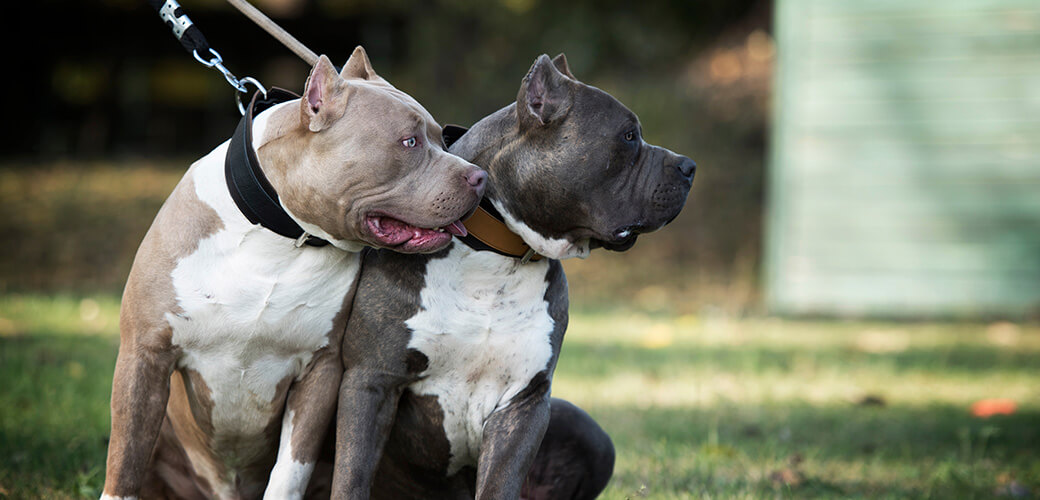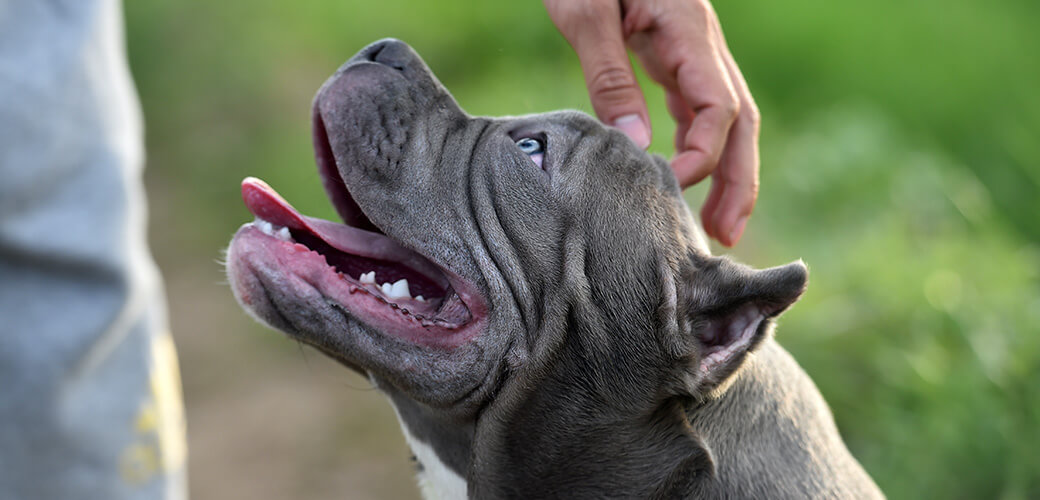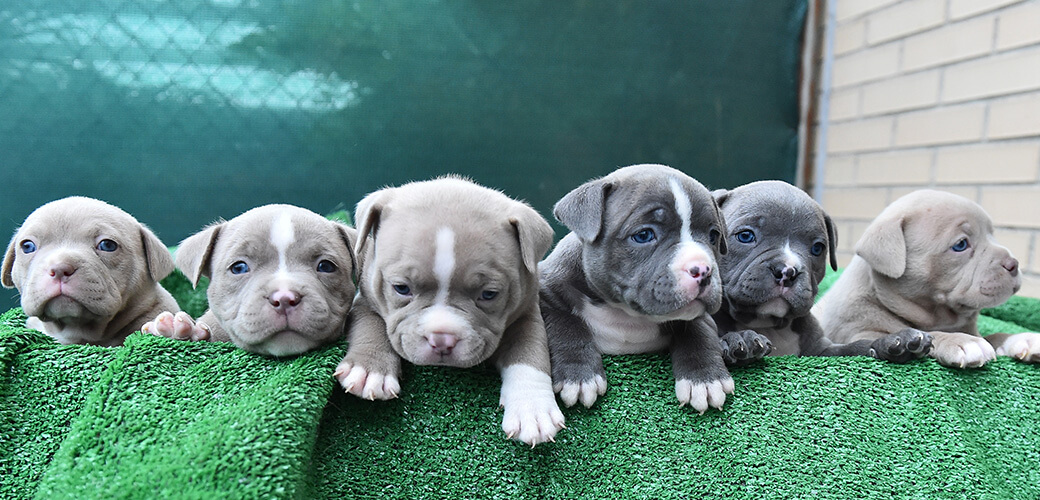The American Bully breed is a loving dog that looks very similar to the American Pit Bull Terrier breed. Their names are often mixed up, but they are two separate breeds with their histories and care needs (no matter how similar those may be). The sad thing is that the American Bully was bred to remove the aggressive traits desired by those who bred Pitbull breeds to fight. The close link between the two has made many people paint them with the same brush, even though the awful past dog fighting rings are mostly behind us.
American Bullies may have a strong build, but they’re nothing to be scared of. Dog breeds with stockier builds are often the most misunderstood dogs out there. They’ll only show aggressive behavior if they learn it from their owners or environment. This guide aims to introduce you to the real American Bully dog and help new dog owners who are considering an American Bully understand how to care for their pup.
Breed Information for the American Bully
- Height: 16 to 20 inches
- Weight: 65 to 85 pounds
- Life expectancy: 8 to 13 years
- Personality: Loving, sweet, friendly
- Parent breeds: American Pit Bull Terrier, Staffordshire Terrier, Bulldog
What is an American Bully?

Though the American Bully resembles the Pitbull, this loveable breed has its common breed standard to help you identify them. There are three major American Bully types: the Pocket American Bully, the Standard American Bully, and the Giant American Bully. Unless otherwise specified, we will be largely talking about the standard version of the American Bully throughout this guide.
The American Bully dog has a muscular body. They’re a stocky breed with a large head and adorable pointed ears. Their muzzle is square, with a bit of loose skin hanging on either side and a defined jaw. Their eyes are often dark brown but can be blue and oval-shaped.
Male American Bullies are always bigger than female American Bullies. Both can be found in a range of coat colors. Each coat color for this breed is as follows:
- Black
- White
- Gray
- Brown
- Tan
- Fawn
- Blue
- Red
- Pie Bald
As a quick side note, the blue Bully dog might sound rare, but they’re a common breed variation. The most common colors for American Bullies are black, fawn, and blue. American Bully breeders may try to pass off blue-coated Bullies are rarer than they are. For those unfamiliar with dogs’ coat colors, “blue” is usually a gray coat with blue undertones.
American Bullies are often thought to be Pitbulls, which makes new dog owners avoid buying them. They may look like Pitbulls, but they aren’t – and neither breed is known to have innate aggressive tendencies. Aggression is something forced on dogs. In actuality, the American Bully breed is very loving. They’re a dog with a sweet nature and have the potential to be excellent family dogs if trained properly.
History of the American Bully
Though the American Kennel Club does not recognize the American Bully as its breed, they are recognized by the American Bully Kennel Club, founded in 2004 to spread proper information about the breed, protect them, and promote them. You won’t find any misinformation about American Bullies from a club created purely out of love for the breed.
The American Bully dog originated in the United States of America sometime between 1980 and 1990, though an exact date isn’t available. As such, they’re a fairly new breed in the dog world and are bred from a mixture of Pitbulls and Terriers and have some Bulldog genetics.
Are American Bullies aggressive?
No dog breeds are aggressive at birth. Aggression is something that dogs learn from their owners, whether they become aggressive out of fear or because it is trained into them. Even the Pitbull, considered one of the “most aggressive” dog breeds, is not an aggressive dog. They are misunderstood because of their past, where they were forced to become aggressive or be abused by their owners. All this is for human entertainment.
You will find that your American Bully dog is very sweet, kind, and loving. Yes, they are a muscular breed that can be very strong, but they won’t just attack you. Dogs attack when provoked or trained to do so. All those videos of Bully breeds attacking other dogs and humans exist because they have awful owners who trained them to attack.
Caring for Your American Bully

Whether you decide to adopt an American Bully or an American Bully Pit, caring for stocky, muscular breeds is pretty simple. They all have short coats, which will only require occasional brushing, and the main thing you’ll need to worry about is any hidden health issues.
When choosing a dog food product for your pup, pick a wholesome food that is free from common allergens and has no filler ingredients. Common filler ingredients include meat by-products, meat or fish meals, and more. You should also avoid unidentified animal protein. If the company won’t say exactly what’s in their product, purchase something else. There are lots of small animal food brands out there that are producing good, healthy food for dogs and other animals that live in domestic settings.
Common American Bully health issues
Before we start listing common health issues that your Bully might see over their lifetime, we’d like to take a moment to warn potential American Bully owners about breeders giving these pups steroids. It sounds awful, and it is. To create a more “desirable” look, some breeders will give American Bullies steroids to bulk up their muscles.
When you adopt or purchase a dog who has been getting steroids, the drugs eventually wear off, and the dog’s size will reduce. This leaves the dog with many health issues, ranging from joint problems to conditions that affect their organs.
Sometimes, breeders give other dog breeds steroids to make them look like American Bully dogs. It’s important to ask for recent vet records for the puppy you’re looking at and their mother because steroids can be passed from the mother dog to her pups if she’s being given the drugs when pregnant.
Only buy from a reputable breeder.
- Brachycephalic Obstructive Airway Syndrome – Sounds scary, doesn’t it? Depending on the shape of your Bully’s face, they may not suffer from this one, but it is a condition often seen in dogs with short snouts and squished faces. The condition makes breathing difficult for afflicted dogs but can usually be corrected with surgery.
- Cherry Eye – A condition named for the protrusion of the red nictitans gland in dogs’ eyes. It may affect one or both eyes and can cause frequent eye infections. The gland can be replaced in surgery.
- Hip and Elbow Dysplasia – This condition is common in many dog breeds, whether your dog’s hips, elbows, or both are affected. Essentially, it occurs when the joints aren’t aligned correctly and can cause pain, soreness, and an inability to walk (depending on the severity of the condition). Dogs with Dysplasia will benefit from joint supplements and further vet guidance.
Keeping your American Bully entertained
Because the Bully was created to be easier to manage than the Pitbull, it’s no surprise that they require less exercise and are very laid-back.
They will enjoy walking but prefer a steady pace and love a long, slow walk where they can explore along the way. Alternatively, try taking your Bully hiking or even swimming if there’s somewhere appropriate nearby. Because they are so close in appearance to Pitbulls, it’s best not to let your Bully off-leash around public members or other dog walkers. It’s not fair, we know, but the Pitbull reputation exceeds itself everywhere.
You can find a quiet field or dog park and take your pup at a time of day when there are fewer people around. This will give you both the opportunity to bond, and you can play with your dog without onlookers around.
Be sure not to take your pup off leash until they are fully trained.
If they won’t stop, stay, come when called, or don’t understand the “leave it” command, it’s best to wait until they do.
Be sure to provide your dog with plenty of mentally stimulating toys when it comes to playtime. Puzzle toys are some of the best because they reward your dog while playing, encouraging them to play more. Playtime is an important part of your American Bully’s day and should never be skipped. You should be spending at least an hour a day just playing with your dog. The best way to do this is to split it into two smaller sessions!
What your American Bully puppy needs

Before they become a full-grown American Bully, your canine companion will go through their puppy years. When your dog is a puppy, they are highly trainable, so this is the best time to train them in the skills they need and the ones you want them to have. For example, if you want your Bully puppy to be a guard dog when they grow up, you’ll need to train them to be less reactive to common day-to-day noises (like the doorbell) and better at identifying threats.
Puppies need appropriate food and toys because they’re smaller than full-grown American Bullies and still in the process of growing. Without appropriate food for puppies, you could deprive your dog of the essential vitamins and minerals they need to grow strong and healthy. Toys are important, too, because dog toys for adult dogs are often larger than what will be comfortable for a puppy.
You’ll also want to invest in puppy mats while potty training your pup. Puppies have small bladders, and they will have accidents while being trained. Remember never to get mad at your dog for having an accident. Just clean it up and disinfect the area to dispel any marking scents. You should also take your puppy outside to see if they need to use the bathroom properly or if they’re done. If it keeps happening, you aren’t letting your dog out enough during the day and should adjust the schedule you have them on.
Schedules are a vital part of training a puppy because they can be extremely energetic before needing to nap. Start their training early, stick to a solid bathroom and feeding schedule, and be sure to take them out for walks when they’re old enough to be outside. Until they can go out in public, leash-train them at home and ensure they get enough exercise.
Remember to use positive reinforcement training when training your dog, no matter what you teach them. Positive reinforcement means praising your dog for any progress they make during training by using treats, positive words, and petting them. Dogs responding well to positivity while being shouted at will only make them hide from you and disrupt their training.
A note on canine separation anxiety
When training your dog and spending time with them, it’s important to encourage them to be independent and not rely on you for answers. Many dog breeds can be prone to separation anxiety, which kicks in when a dog’s owner leaves them alone for long periods.
If you’re going to own a dog, you need to be certain that they won’t be alone all day without anyone to socialize with. Another dog can help the situation if both are introduced properly, but there’s nothing quite like a reassuring human presence.
For dogs showing severe separation anxiety, owners should consider veterinary guidance and hire a skilled dog trainer. Your vet will be able to investigate any other causes of your dog’s stress, while a dog trainer can help you work with your dog to form a healthier level of attachment and learn how to be without you. Dogs with anxiety are sometimes prescribed medication to help them during treatment. It’s possible for dogs with this kind of anxiety to regain their confidence and live better lives.
FAQs:
Q: How big do American Bullies get?
A: The standard American Bully will grow between 16 and 20 inches from the floor to their shoulder. However, the giant version of this breed can be a few inches taller. If you buy an American Bully with the genetics to be a Giant, they may grow up to 23 inches tall. Despite being called a “Giant”, they are only an average of three inches taller than standard American Bully dogs and nowhere near the height of some of the world’s tallest dog breeds.
Q: Are the American Bully and American Bully Pitbull the same breed?
A: An interesting question! The answer is yes and no. The American Bully is a descendant of the American Pitbull Terrier, and the American Bully Pitbull is a crossbreed between the American Bully and the Pitbull Terrier. Essentially, both dogs have similar genetics, but the Bully Pit is a backcross breed, while the American Bully is just a crossbreed. They aren’t the same dog but only because one has extra Pitbull traits from the backcross breeding process.
Q: What is a Pocket Bully dog?
A: A Pocket Bully is a small American Bully dog. These smaller dogs are considered miniature versions of the American Bully and cannot be purebred American Bully dogs because they can only be produced by crossing an American Bully and a Patterdale Terrier. They usually don’t get much bigger than 16 to 17 inches, regardless of being male or female, and shouldn’t be any smaller than 13 inches tall.
Q: How much are American Bully puppies?
A: You can expect to pay upwards of $2,000 UDS for an American Bully dog. Depending on the breeder’s practices, you may find these pups for a more affordable price. But, always be wary about buying from breeders online. Look for reviews from other customers, ask for vet records, and never pay a deposit in advance before actually seeing the dog. There are a lot of scams out there, and it’s very easy to be trapped by one.

